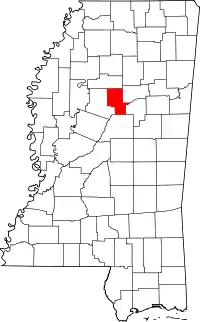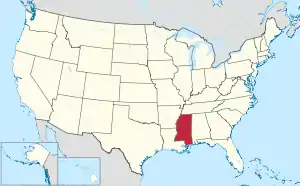Montgomery County, Mississippi
Montgomery County is a county located in the U.S. state of Mississippi. As of the 2020 census, the population was 9,822.[1] Its county seat is Winona.[2]
Montgomery County | |
|---|---|
 U.S. Post Office in Winona. | |
 Location within the U.S. state of Mississippi | |
 Mississippi's location within the U.S. | |
| Coordinates: 33°30′N 89°37′W | |
| Country | |
| State | |
| Founded | 1871 |
| Seat | Winona |
| Largest city | Winona |
| Area | |
| • Total | 408 sq mi (1,060 km2) |
| • Land | 407 sq mi (1,050 km2) |
| • Water | 0.9 sq mi (2 km2) 0.2% |
| Population (2020) | |
| • Total | 9,822 |
| • Density | 24/sq mi (9.3/km2) |
| Time zone | UTC−6 (Central) |
| • Summer (DST) | UTC−5 (CDT) |
| Congressional district | 2nd |
| Website | www |
The county is said to be named in honor either of Richard Montgomery, an American Revolutionary War general killed in 1775 while attempting to capture Quebec City, Canada, or for Montgomery County, Tennessee, from which an early settler came. In the latter case, it would have been indirectly named after John Montgomery, a settler in Montgomery County, Tennessee, who founded the city of Clarksville, Tennessee, in the same county.
The Big Black River passes through the southern part of the county, flowing southwest to its confluence with the Mississippi River south of Vicksburg.[3]
Geography
According to the U.S. Census Bureau, the county has a total area of 408 square miles (1,060 km2), of which 407 square miles (1,050 km2) is land and 0.9 square miles (2.3 km2) (0.2%) is water.[4] It is the fourth-smallest county in Mississippi by total area.
Major highways
Adjacent counties
- Grenada County (north)
- Webster County (northeast)
- Choctaw County (east)
- Attala County (south)
- Carroll County (west)
History
This area was occupied in historic times by the Choctaw people. Their ancestors had inhabited the area for thousands of years. Under the Indian Removal Act of 1830, the United States forced most of the Native Americans west of the Mississippi River in order to open their lands to settlement by European Americans.
Much of the area of present-day Montgomery County was developed for cotton plantations before and after the Civil War, when it was still part of Choctaw County. Most of the labor was supplied by African Americans, enslaved before the war and freed afterward. The county was organized by the legislature in 1871, during the Reconstruction era. The eastern hilly areas became a center of timber industry.
From 1877 to 1950, there were 10 known lynchings of blacks in the county, fewer than in many other counties of the state.[5] It was a form of racial terrorism that was at its height at the turn of the 20th century.[5] Some studies have shown that the rate of lynchings related to economic stresses among whites. Beginning in 1890, Mississippi and other southern states largely excluded blacks from the formal political system by disenfranchisement, creating barriers to voter registration through constitutional amendments and other laws.
On April 13, 1937, two African-American men, Roosevelt Townes and "Bootjack" McDaniels, were arraigned at the county courthouse in Winona, after being charged in the December 1936 murder of a white merchant in Duck Hill, after Townes purportedly confessed to police. They were abducted from the courthouse and lynched. A white crowd estimated at 100 had gathered on April 13. A group of 12 white men took the two blacks by school bus to a site in Duck Hill, where they were tortured to confess before being shot and burned to death.[6] A crowd estimated at 300 to 500 whites gathered to watch. By 1 pm, the wire services and other national media had learned of the event and were trying to gain more information.[6]
The lynchings were reported nationally in the United States and widely condemned. Representative Hatton W. Sumners (D-Texas), chairman of the House Judiciary Committee, sent a telegram to Governor Hugh L. White decrying the lynching. He said, "It is the sort of thing which makes it hard for those of us who are here trying to protect the governmental sovereignty of the state..."[6] At the time a federal anti-lynching bill was under consideration by Congress. It passed the House, but it was defeated in the Senate by the Solid South, conservative white Democrats.[7][8] As was typical of lynchings, no one was ever prosecuted for the murders.[9] Nazi Germany reported the lynching, comparing it to the "humanism" of its anti-Semitic laws.[10]
As in much of rural Mississippi, population in this county declined markedly from 1910 to 1920, and from 1940 to 1970. The peak of population in the county was in 1910. In addition to labor changes because of mechanization of agriculture, blacks left in two waves of the Great Migration out of the rural and small town South seeking jobs, education, relief from Jim Crow and violence, and better opportunities in other regions. As a result, Mississippi changed from majority black (56%) in population in 1910 to majority white (63%) by 1970.[11]
Demographics
| Census | Pop. | Note | %± |
|---|---|---|---|
| 1880 | 13,348 | — | |
| 1890 | 14,459 | 8.3% | |
| 1900 | 16,536 | 14.4% | |
| 1910 | 17,706 | 7.1% | |
| 1920 | 13,805 | −22.0% | |
| 1930 | 15,009 | 8.7% | |
| 1940 | 15,703 | 4.6% | |
| 1950 | 14,470 | −7.9% | |
| 1960 | 13,320 | −7.9% | |
| 1970 | 12,918 | −3.0% | |
| 1980 | 13,366 | 3.5% | |
| 1990 | 12,388 | −7.3% | |
| 2000 | 12,189 | −1.6% | |
| 2010 | 10,925 | −10.4% | |
| 2020 | 9,822 | −10.1% | |
| U.S. Decennial Census[12] 1790-1960[13] 1900-1990[14] 1990-2000[15] 2010-2013[16] | |||
2020 census
| Race | Num. | Perc. |
|---|---|---|
| White (non-Hispanic) | 5,094 | 51.86% |
| Black or African American (non-Hispanic) | 4,364 | 44.43% |
| Native American | 9 | 0.09% |
| Asian | 24 | 0.24% |
| Other/Mixed | 225 | 2.29% |
| Hispanic or Latino | 106 | 1.08% |
As of the 2020 United States census, there were 9,822 people, 4,539 households, and 3,064 families residing in the county.
2010 census
As of the 2010 United States Census, there were 10,925 people living in the county. 53.0% were White, 45.5% Black or African American, 0.4% Asian, 0.1% Native American, 0.5% of some other race and 0.5% of two or more races. 0.9% were Hispanic or Latino (of any race).
2000 census
As of the census[18] of 2000, there were 12,189 people, 4,690 households, and 3,367 families living in the county. The population density was 30 people per square mile (12 people/km2). There were 5,402 housing units at an average density of 13 per square mile (5.0/km2). The racial makeup of the county was 54.25% White, 44.95% Black or African American, 0.08% Native American, 0.25% Asian, 0.02% Pacific Islander, 0.07% from other races, and 0.37% from two or more races. 0.85% of the population were Hispanic or Latino of any race.
According to the census[18] of 2000, the largest ancestry groups in Montgomery County were African 44.95%, English 42.1%, and Scots-Irish 1%.
There were 4,690 households, out of which 32.60% had children under the age of 18 living with them, 48.50% were married couples living together, 18.80% had a female householder with no husband present, and 28.20% were non-families. 26.10% of all households were made up of individuals, and 13.60% had someone living alone who was 65 years of age or older. The average household size was 2.57 and the average family size was 3.10.
In the county, the population was spread out, with 26.80% under the age of 18, 8.90% from 18 to 24, 25.30% from 25 to 44, 22.40% from 45 to 64, and 16.70% who were 65 years of age or older. The median age was 37 years. For every 100 females there were 86.40 males. For every 100 females age 18 and over, there were 81.10 males.
The median income for a household in the county was $25,270, and the median income for a family was $31,602. Males had a median income of $26,590 versus $17,639 for females. The per capita income for the county was $14,040. About 21.90% of families and 24.30% of the population were below the poverty line, including 34.80% of those under age 18 and 25.40% of those age 65 or over.
Education
- Public School Districts
- Winona-Montgomery Consolidated School District[19] - Consolidation of the Winona district and the Montgomery County School District, effective 2018.[20]
- Private Schools
- Winona Christian School
Communities
Cities
- Winona (county seat)
Towns
Census-designated place
Unincorporated communities
Ghost town
Notable residents
- Fannie Lou Hamer - Civil rights activist, with the Mississippi Freedom Democratic Party in 1964; born in Montgomery County in 1917, moved to Sunflower County in 1919.[21]
Politics
| Year | Republican | Democratic | Third party | |||
|---|---|---|---|---|---|---|
| No. | % | No. | % | No. | % | |
| 2020 | 2,917 | 57.48% | 2,121 | 41.79% | 37 | 0.73% |
| 2016 | 2,818 | 56.41% | 2,115 | 42.33% | 63 | 1.26% |
| 2012 | 2,947 | 52.21% | 2,675 | 47.39% | 23 | 0.41% |
| 2008 | 3,071 | 53.76% | 2,609 | 45.68% | 32 | 0.56% |
| 2004 | 3,002 | 54.61% | 2,473 | 44.99% | 22 | 0.40% |
| 2000 | 2,630 | 54.24% | 2,187 | 45.10% | 32 | 0.66% |
| 1996 | 1,943 | 47.15% | 1,970 | 47.80% | 208 | 5.05% |
| 1992 | 2,324 | 48.66% | 2,076 | 43.47% | 376 | 7.87% |
| 1988 | 2,504 | 56.79% | 1,893 | 42.93% | 12 | 0.27% |
| 1984 | 3,093 | 62.07% | 1,881 | 37.75% | 9 | 0.18% |
| 1980 | 2,479 | 46.55% | 2,730 | 51.26% | 117 | 2.20% |
| 1976 | 2,278 | 47.19% | 2,410 | 49.93% | 139 | 2.88% |
| 1972 | 3,210 | 76.32% | 925 | 21.99% | 71 | 1.69% |
| 1968 | 475 | 10.90% | 896 | 20.56% | 2,988 | 68.55% |
| 1964 | 3,181 | 95.53% | 149 | 4.47% | 0 | 0.00% |
| 1960 | 585 | 29.71% | 623 | 31.64% | 761 | 38.65% |
| 1956 | 278 | 15.63% | 1,134 | 63.74% | 367 | 20.63% |
| 1952 | 840 | 38.25% | 1,356 | 61.75% | 0 | 0.00% |
| 1948 | 35 | 2.04% | 105 | 6.13% | 1,574 | 91.83% |
| 1944 | 74 | 5.12% | 1,371 | 94.88% | 0 | 0.00% |
| 1940 | 44 | 2.83% | 1,509 | 97.10% | 1 | 0.06% |
| 1936 | 5 | 0.36% | 1,383 | 99.64% | 0 | 0.00% |
| 1932 | 17 | 1.23% | 1,366 | 98.70% | 1 | 0.07% |
| 1928 | 98 | 5.75% | 1,607 | 94.25% | 0 | 0.00% |
| 1924 | 60 | 5.13% | 1,015 | 86.75% | 95 | 8.12% |
| 1920 | 57 | 6.22% | 846 | 92.26% | 14 | 1.53% |
| 1916 | 35 | 3.31% | 997 | 94.41% | 24 | 2.27% |
| 1912 | 4 | 0.54% | 697 | 93.94% | 41 | 5.53% |
References
- "Census - Geography Profile: Montgomery County, Mississippi". United States Census Bureau. Retrieved January 14, 2023.
- "Find a County". National Association of Counties. Retrieved June 7, 2011.
- "Big Black River Basin". Mississippi Department of Environmental Quality. Archived from the original on September 23, 2006. Retrieved October 20, 2006.
- "2010 Census Gazetteer Files". United States Census Bureau. August 22, 2012. Archived from the original on September 28, 2013. Retrieved November 6, 2014.
- Lynching in America, 2nd edition Archived 2018-06-27 at the Wayback Machine, Supplement by County, p. 5, Eji.org
- "Roosevelt Townes and Robert "Bootjack" McDaniels", Northeastern University's Center for Civil Rights and Restorative Justice; News Articles: "Dual Lynching Nationally Condemned" and "Mob Lynches Two Negroes Tuesday near Duck Hill" Archived 2014-09-23 at the Wayback Machine, Winona Times, 15 April 1937; accessed 18 March 2017
- Vanessa A. Holloway (2014). Getting Away with Murder: The Twentieth-Century Struggle for Civil Rights in the U.S. Senate. University Press of America. pp. 25–28. ISBN 9780761864332.
- Weiss, Nancy Joan (1983). Farewell to the Party of Lincoln: Black Politics in the Age of FDR. Princeton University.
- ""Roosevelt Townes and Robert "Bootjack" McDaniels"" (PDF). Northeastern University's Center for Civil Rights and Restorative Justice. Archived from the original (PDF) on September 23, 2014. Retrieved March 18, 2017.
- "Lynchings Top NAZI Papers". San Jose News. April 13, 1937.
- Gibson, Campbell and Kay Jung (September 2002). Historical Census Statistics on Population Totals By Race, 1790 to 1990, and By Hispanic Origin, 1970 to 1990, For The United States, Regions, Divisions, and States. Archived 2008-07-25 at the Wayback Machine U.S. Bureau of the Census - Population Division.
- "U.S. Decennial Census". United States Census Bureau. Retrieved November 6, 2014.
- "Historical Census Browser". University of Virginia Library. Retrieved November 6, 2014.
- "Population of Counties by Decennial Census: 1900 to 1990". United States Census Bureau. Retrieved November 6, 2014.
- "Census 2000 PHC-T-4. Ranking Tables for Counties: 1990 and 2000" (PDF). United States Census Bureau. Retrieved November 6, 2014.
- "State & County QuickFacts". United States Census Bureau. Archived from the original on June 7, 2011. Retrieved September 4, 2013.
- "Explore Census Data". data.census.gov. Retrieved December 12, 2021.
- "U.S. Census website". United States Census Bureau. Retrieved January 31, 2008.
-
- 2020 Map: "2020 CENSUS - SCHOOL DISTRICT REFERENCE MAP: Montgomery County, MS" (PDF). U.S. Census Bureau. Retrieved July 18, 2022. - Text list - In 2020 there was one school district
- 2010 Map: "SCHOOL DISTRICT REFERENCE MAP (2010 CENSUS): Montgomery County, MS" (PDF). U.S. Census Bureau. Retrieved July 18, 2022. - Text list - In 2010 there were two school districts
- "School District Consolidation in Mississippi Archived 2017-07-02 at the Wayback Machine." Mississippi Professional Educators. December 2016. Retrieved on July 2, 2017. Page 2 (PDF p. 3/6).
- Barnwell, p. 225 - Excerpt of: Mills, Kay This Little Light of Mine. In: Barnwell, Marion (editor) A Place Called Mississippi: Collected Narratives. University Press of Mississippi, 1997. ISBN 1617033391, 9781617033391.
- Leip, David. "Dave Leip's Atlas of U.S. Presidential Elections". Uselectionatlas.org. Retrieved August 12, 2017.